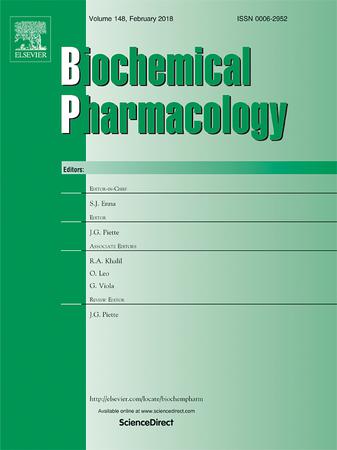SIRT-2 inhibition by AK-7 orchestrates fibrotic cascades in airways through neuroimmune interaction via TRPA1, TRPM8 and TGF-β signalling
IF 5.3
2区 医学
Q1 PHARMACOLOGY & PHARMACY
引用次数: 0
Abstract
Chronic obstructive pulmonary diseases (COPD) is characterized by airflow limitation, chronic inflammation and airway remodeling (AR) in airways and lung parenchyma. AR, a lung response, involves mucus production, airflow issues, and structural changes. It is exacerbated by neurogenic inflammation from activated sensory nerves, highlighting the interplay between neuronal and immune regulation in COPD. Sirtuins play a crucial role in lung remodeling, with SIRT-2 being the least studied. Present study explores how SIRT-2 regulates neurogenic inflammation and fibrosis in experimental BALB/c mice with cigarette smoke-induced COPD. Mice from each group, except the control, were exposed to CS for 60 days and AK-7 (100ug/kg and 200ug/kg) was administered intranasally. The study evaluated lung injury and inflammation marked by increased Cortisol, ACTH, COX-2 and LDH in COPD group with its attenuation by SIRT-2 inhibition. Additionally, CS exposure exhibited neurogenic inflammation represented by activated TPRV1 and TRPM8, elevated neuromediators levels (dopamine, acetylcholine, substance P, serotonin) and their respective receptors which were mitigated by AK-7. CS exposure enhanced fibrosis by targeting the fibrotic cascade, enhancing MMP-9, total collagen, hydroxyproline, and upregulating αSMA, MUC5AC, TGF-β, PKA, GATA-3, FOXO3, and STAT-6. SIRT-2 inhibition effectively reversed all these factors suppressing fibrosis further supported by downregulated SIRT-2 expression and histopathological studies where collagen deposition and mucus production were also attenuated by AK-7. Molecular docking revealed strong binding affinity of certain protein such as COX-2, D5DR and 5HT with AK-7. Overall, targeting SIRT-2 to modulate neuro-immune interplay presents a promising therapeutic approach for addressing AR in COPD.

AK-7对SIRT-2的抑制通过TRPA1、TRPM8和TGF-β信号传导的神经免疫相互作用调控气道纤维化级联反应。
慢性阻塞性肺疾病(COPD)以气道和肺实质的气流受限、慢性炎症和气道重塑(AR)为特征。AR是一种肺部反应,包括粘液产生、气流问题和结构改变。由激活的感觉神经引起的神经源性炎症加重了慢性阻塞性肺病,突出了慢性阻塞性肺病中神经元和免疫调节之间的相互作用。Sirtuins在肺重塑中起着至关重要的作用,其中SIRT-2被研究得最少。本研究探讨了SIRT-2如何调节实验性BALB/c小鼠香烟烟雾诱导的COPD的神经源性炎症和纤维化。除对照组外,各组小鼠暴露于CS 60 天,AK-7 (100ug/kg和200ug/kg)经鼻给药。本研究评估COPD组以皮质醇、ACTH、COX-2和LDH升高为特征的肺损伤和炎症,并通过抑制SIRT-2来减弱。此外,CS暴露表现出神经源性炎症,表现为激活的TPRV1和TRPM8,升高的神经介质水平(多巴胺,乙酰胆碱,P物质,血清素)及其各自的受体,AK-7减轻。CS暴露通过靶向纤维化级联,增强MMP-9、总胶原蛋白、羟脯氨酸,上调αSMA、MUC5AC、TGF-β、PKA、GATA-3、FOXO3和STAT-6来增强纤维化。SIRT-2抑制有效地逆转了所有这些抑制纤维化的因素,这进一步得到了SIRT-2表达下调和组织病理学研究的支持,AK-7也减弱了胶原沉积和粘液产生。分子对接显示COX-2、D5DR、5HT等蛋白与AK-7具有较强的结合亲和力。总的来说,靶向SIRT-2调节神经免疫相互作用是解决COPD中AR的一种有希望的治疗方法。
本文章由计算机程序翻译,如有差异,请以英文原文为准。
求助全文
约1分钟内获得全文
求助全文
来源期刊

Biochemical pharmacology
医学-药学
CiteScore
10.30
自引率
1.70%
发文量
420
审稿时长
17 days
期刊介绍:
Biochemical Pharmacology publishes original research findings, Commentaries and review articles related to the elucidation of cellular and tissue function(s) at the biochemical and molecular levels, the modification of cellular phenotype(s) by genetic, transcriptional/translational or drug/compound-induced modifications, as well as the pharmacodynamics and pharmacokinetics of xenobiotics and drugs, the latter including both small molecules and biologics.
The journal''s target audience includes scientists engaged in the identification and study of the mechanisms of action of xenobiotics, biologics and drugs and in the drug discovery and development process.
All areas of cellular biology and cellular, tissue/organ and whole animal pharmacology fall within the scope of the journal. Drug classes covered include anti-infectives, anti-inflammatory agents, chemotherapeutics, cardiovascular, endocrinological, immunological, metabolic, neurological and psychiatric drugs, as well as research on drug metabolism and kinetics. While medicinal chemistry is a topic of complimentary interest, manuscripts in this area must contain sufficient biological data to characterize pharmacologically the compounds reported. Submissions describing work focused predominately on chemical synthesis and molecular modeling will not be considered for review.
While particular emphasis is placed on reporting the results of molecular and biochemical studies, research involving the use of tissue and animal models of human pathophysiology and toxicology is of interest to the extent that it helps define drug mechanisms of action, safety and efficacy.
 求助内容:
求助内容: 应助结果提醒方式:
应助结果提醒方式:


